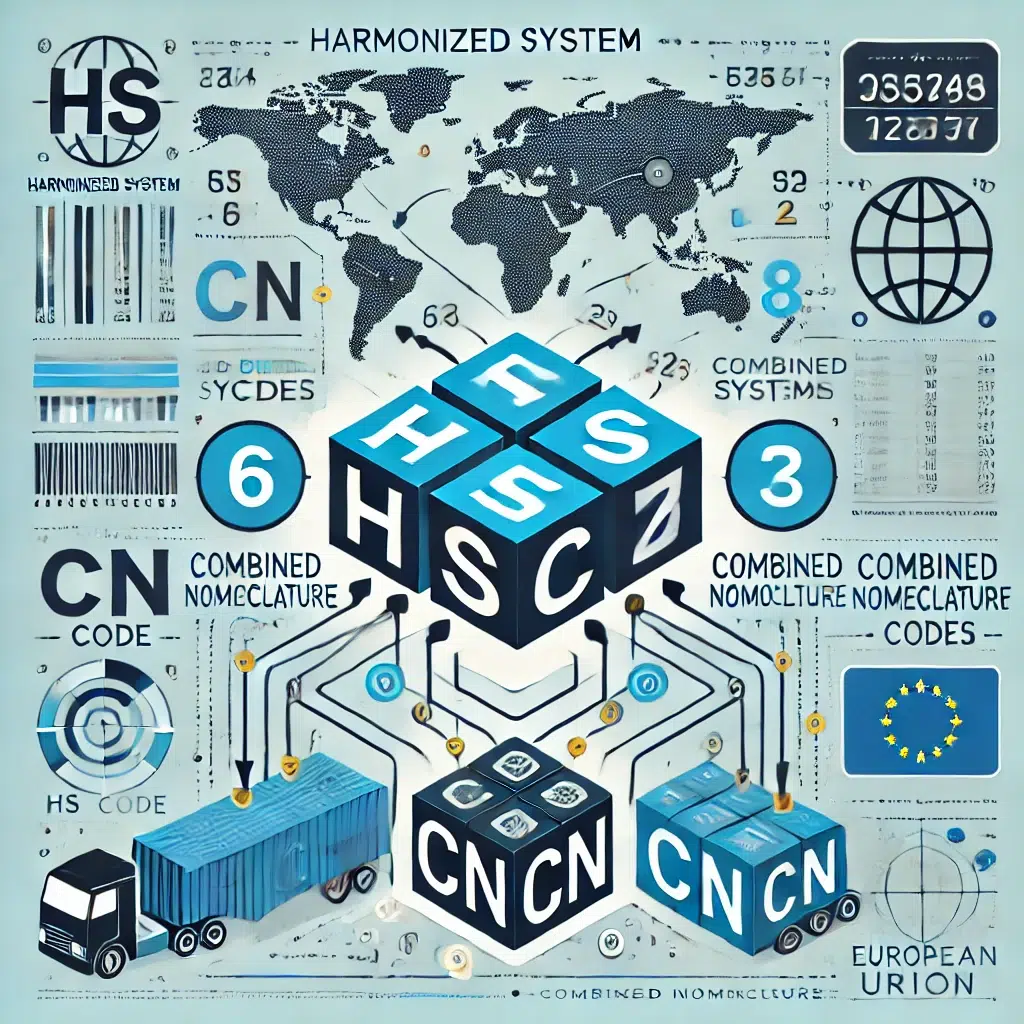If you are involved in international trade as a buyer, it is essential to understand what HS code is and how it affects your business. The Harmonized System (HS) code is a standardized numerical classification system that is used to identify products in international trade. In this blogpost we will cover what buyers need to know about HS code.
Table of Contents
The HS code is a six-digit code that is assigned to each product that is traded internationally. The first two digits of the HS code represent the chapter, the next two digits represent the heading, and the last two digits represent the subheading. For example, the HS code for coffee is 0901.21, where 09 represents the chapter for coffee, tea, mate, and spices, 01 represents the heading for coffee, and 21 represents the subheading for roasted coffee.
Why is it important to understand HS code as a buyer?
Tariff classification: HS code is used to classify products for customs purposes. Each HS code has a corresponding tariff rate, and the correct classification of a product is crucial for determining the correct amount of duty to be paid. If you misclassify a product, you may end up paying a higher duty rate than necessary, which can significantly impact your bottom line.
Compliance with regulations: Many countries have regulations that restrict the importation of certain products. The HS code can help you determine whether your product is subject to any regulations or restrictions, such as health and safety standards, environmental regulations, or intellectual property restrictions. Understanding these regulations is essential to ensure that your product meets all the requirements for importation.
Market research: HS code can be used for market research to identify potential opportunities in foreign markets. By understanding the HS codes for your products, you can analyze the export data to determine which countries are importing similar products and the potential demand for your product in those markets.
Shipping and logistics: HS code is also used for shipping and logistics purposes. The correct HS code is essential for filling out shipping documents and ensuring that your product is handled properly during transportation. The HS code can also be used to determine the correct packaging requirements, labeling, and other transportation-related requirements.
RFQ data: In RFQs each product sourced should included HS code, preferable set by the supplier providing the quote.
HS code in market research
HS codes are widely used in market research to identify potential opportunities in foreign markets. Here are some examples of market research where HS code is used:
- Identifying potential export markets: Exporters can use HS codes to analyze export data and identify potential markets for their products. By looking at the HS code for their products and comparing it with the export data, they can determine which countries are importing similar products and the potential demand for their products in those markets.
- Tracking market trends: Market researchers can use HS codes to track market trends and analyze changes in demand for certain products. By monitoring changes in the HS codes for different products, researchers can identify emerging markets, track changes in consumer preferences, and anticipate shifts in demand.
- Competitive analysis: HS codes can be used for competitive analysis to identify key players in a particular market. By analyzing the HS codes for a product category, researchers can identify the major importers and exporters of that product and their market share.
- Identifying trade barriers: HS codes can be used to identify trade barriers and restrictions in different markets. By analyzing the HS codes for their products, exporters can determine whether their products are subject to any regulations or restrictions, such as health and safety standards, environmental regulations, or intellectual property restrictions.
- Product development: HS codes can be used for product development to identify potential markets for new products. By analyzing the HS codes for related products, researchers can determine the potential demand for a new product in different markets and identify any regulatory barriers to entry.
Sources where HS-code based market research can be found
- Customs data: Customs data is one of the primary sources of market data that use HS codes. It provides information on the import and export of goods between countries, including the HS codes, quantities, and values of goods traded. Customs data is often used for market research and analysis of trade trends.
- Trade associations: Many trade associations collect market data from their members, including information on the HS codes of the products they trade. This data can be used to analyze market trends, identify market opportunities, and conduct competitive analysis.
- Market research firms: Market research firms often use HS codes to collect and analyze market data. They use various research methods, including surveys, focus groups, and online research, to gather data on consumer behavior, product preferences, and market trends.
- Industry publications: Industry publications, such as trade magazines and journals, often use HS codes to classify products and report on market trends. These publications are a valuable source of information on new products, industry trends, and market developments.
- Online marketplaces: Online marketplaces, such as Alibaba, Amazon, and eBay, use HS codes to classify products and facilitate international trade. These platforms provide valuable data on product demand, pricing, and competition in different markets.
HS code and CN code
The HS code (Harmonized System code) and the CN code (Combined Nomenclature code) are closely connected as they both relate to the classification of goods in international trade, but they serve slightly different purposes and are used at different levels of trade regulation.
Understanding CN Code
- CN Code stands for Combined Nomenclature, which is the European Union’s specific classification system for goods.
- The CN code is an 8-digit code used by EU member states. It incorporates the 6-digit HS code and adds two additional digits for further specification at the EU level.
- The Combined Nomenclature is updated annually by the European Commission and is used for EU customs duties and trade statistics.
Connection Between HS Code and CN Code

- Foundation:
- The first 6 digits of the CN code are identical to the HS code. This means that the CN code is built on the HS code, ensuring that the classification of goods is consistent with international standards.
- Additional Digits:
- The 7th and 8th digits in the CN code provide further detail specific to the European Union. These additional digits allow the EU to apply more precise classification, enabling better management of EU-specific tariffs, trade policies, and statistical requirements.
- Regulatory Framework:
- The CN code is governed by Council Regulation (EEC) No 2658/87, which established the Combined Nomenclature and Common Customs Tariff. This regulation ensures that the CN code reflects changes in technology, trade patterns, and legal requirements within the EU.
- Application:
- Both HS and CN codes are used for customs declarations, determining import/export duties, and compiling trade statistics. For goods entering or exiting the EU, the CN code is the required classification, while the HS code provides the international basis for this classification.
Including HS code in your Frame agreement
Including clear provisions about HS codes in your procurement framework contracts is essential for ensuring smooth international trade. HS codes classify goods for customs purposes, and incorrect or missing codes can lead to costly delays, penalties, and compliance issues. To avoid these risks, your contracts should specify that the supplier is responsible for providing accurate HS codes on all relevant documentation. Both parties should verify and mutually agree on these codes before shipment to prevent disputes.
Additionally, your contract should hold the supplier accountable for any errors, making them liable for costs or delays caused by incorrect HS codes. It’s also important to require that the supplier keeps these codes updated according to the latest trade regulations and notifies you of any changes. Lastly, having a dispute resolution mechanism in place for disagreements over HS codes ensures that issues can be resolved efficiently, avoiding disruptions to your supply chain. By addressing HS codes comprehensively in your contracts, you protect your organization from unnecessary risks and ensure smoother international transactions.
HS Code Compliance Clause
Example for educational purposes. Always adapt clauses to your conditions.
1. Provision of HS Codes:
- The Supplier shall provide accurate Harmonized System (HS) codes for all goods supplied under this Agreement. These HS codes must be clearly stated on all relevant shipping documents, invoices, and any other documentation required by customs authorities.
2. Verification and Agreement:
- Both Parties agree to verify and mutually confirm the accuracy of the HS codes provided by the Supplier prior to the shipment of goods. In the event of any discrepancy, the Parties shall resolve the issue in good faith before the goods are dispatched.
3. Liability for Incorrect HS Codes:
- The Supplier shall be liable for any additional costs, delays, penalties, or liabilities incurred by the Buyer as a result of incorrect or outdated HS codes provided by the Supplier. The Buyer reserves the right to recover such costs from the Supplier.
4. Updates and Compliance:
- The Supplier shall ensure that the HS codes provided are up-to-date and comply with the latest international trade regulations. The Supplier shall promptly notify the Buyer of any changes to the HS codes that may affect the classification of the goods.
Summary: What buyers need to know about HS code
In conclusion, professional buyers need to know about HS code when involved in international trade. It can help you determine the correct tariff rate, ensure compliance with regulations, (conduct market research), and facilitate shipping and logistics. By correctly classifying your products using the HS code, you can avoid costly mistakes and ensure that your business runs smoothly in the global market. Learn more about the HS-Convention.
The HS code and the CN code are interconnected as part of the global and European systems for classifying goods in international trade. The CN code extends the HS code by adding two additional digits, allowing the EU to apply more detailed classifications specific to its trade needs. Together, these codes ensure that goods are consistently categorized for customs and statistical purposes, both internationally and within the European Union.
What buyers need to know about HS code is included in TCO (Total Cost of Ownership) and determining the BCC (Best Cost Country)
In RFQ template course you can learn more about the documents required in a successful Request to the market. When developing a RFQ, certain information is required in order for the suppliers to provide a strong and relevant quotation and give the buyer the possibility to build a competitive supply chain. But depending on the market conditions, and the sourcing tactics, consideration need to be made in order to create the desired negotiation position and, at the end, the desired relation to the selected supplier. This is what buyers need to know about HS code
Note: Illustration to the blogpost “What buyers need to know about HS code” was created by DALL-E on March 13, 2023.
